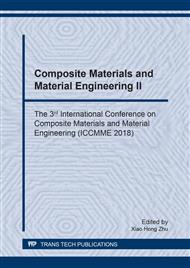p.139
p.144
p.150
p.156
p.162
p.168
p.177
p.183
p.188
Multi Objective Optimization of Wear Behaviour of In Situ AA8011-ZrB2 Metal Matrix Composites by Using Taguchi-Grey Analysis
Abstract:
Composite materials with aluminium alloy 8011 matrix and 0, 4 and 8 weight percentages of ZrB2 reinforcements were synthesized by in-situ stir casting process. The presence and homogeneous distribution of the reinforcements were examined with X-ray diffraction analysis and scanning electron microscopic analysis. To investigate the effect of dry sliding wear parameters such as sliding distance, percentage reinforcement, load, sliding velocity and temperature on wear rate and co-efficient of friction, experiments were conducted using a pin on disc wear tester as per Taguchi’s orthogonal array design and the tribological behaviour of synthesized composites was investigated by statistical techniques. Significance and the influence of the parameters over the response were determined by analysis of variances and grey relational analysis was used to find the optimal combination of parameters to obtain minimum wear rate and co-efficient of friction.
Info:
Periodical:
Pages:
162-167
Citation:
Online since:
August 2018
Price:
Сopyright:
© 2018 Trans Tech Publications Ltd. All Rights Reserved
Share:
Citation:


